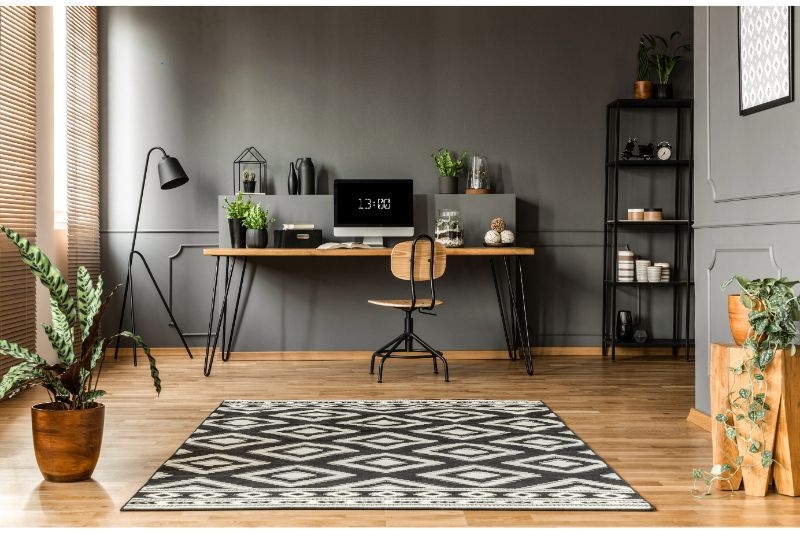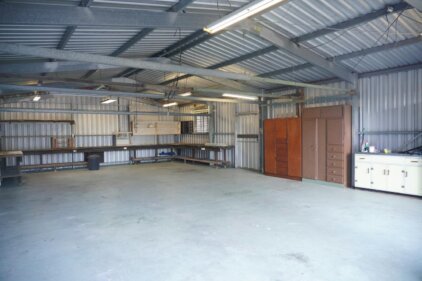Benefits of a Well-Designed Home Office
Designing a thoughtful and ergonomic home office space can bring a multitude of benefits to your work life and overall productivity. Here are some of the key advantages:
- Increased Efficiency: A well-designed home office with the right furniture, equipment, and layout can help you work more efficiently, reducing distractions and streamlining your workflow.
- Improved Focus: A dedicated and distraction-free home office environment can help you maintain better focus and concentration, leading to higher-quality work.
- Enhanced Creativity: Personalized touches and a motivating atmosphere in your home office can spark creativity and inspire innovative thinking.
- Better Work-Life Balance: Establishing clear boundaries between your work and personal spaces can help you maintain a healthy work-life balance and prevent burnout.
- Reduced Stress: A comfortable and ergonomic workspace can help alleviate physical discomfort and reduce stress levels, contributing to your overall well-being.
Assessing Your Needs and Setting Goals for Your Home Office
Before you embark on designing your perfect home office, it’s crucial to take the time to assess your specific needs and set clear goals for your workspace. Consider the following factors:
- Work Tasks and Responsibilities: Evaluate the type of work you’ll be doing in your home office, such as writing, research, video conferencing, or creative projects. This will help you determine the necessary equipment, furniture, and layout.
- Space Availability: Measure the available space you have for your home office and consider how you can best utilize the area to meet your needs.
- Ergonomic Requirements: Identify any ergonomic needs, such as the proper desk height, chair support, or lighting requirements, to ensure your workspace is comfortable and supportive.
- Technological Needs: Assess the technology and digital tools you’ll need, such as a reliable internet connection, computer, printer, or video conferencing equipment.
- Personal Preferences: Consider your personal style, color preferences, and any inspirational elements you’d like to incorporate into your home office design.
By thoroughly assessing your needs and setting clear goals, you’ll be able to create a tailored home office space that maximizes your productivity and aligns with your unique requirements.
Choosing the Right Location for Your Home Office
Selecting the right location for your home office is crucial for creating a productive and distraction-free environment. Here are some factors to consider when choosing the perfect spot:
- Privacy: Identify a quiet and secluded area in your home that offers privacy and minimal distractions from household activities or family members.
- Natural Light: Whenever possible, choose a location that receives ample natural light, as this can enhance your mood, energy levels, and overall well-being.
- Noise Levels: Avoid areas with high noise levels, such as near the television, kitchen, or high-traffic zones, as these can be detrimental to your focus and concentration.
- Accessibility: Ensure the location is easily accessible and convenient for your daily work routine, with minimal disruptions or interruptions.
- Flexibility: Consider a space that can be easily adapted or expanded as your needs or work requirements change over time.
By carefully selecting the right location for your home office, you’ll be able to create a dedicated and distraction-free workspace that supports your productivity and overall well-being.
Selecting the Right Furniture and Equipment for Your Home Office
Choosing the appropriate furniture and equipment for your home office is crucial for creating a comfortable and efficient workspace. Here are some key considerations:
- Desk: Select a desk that is the right size for your space and offers ample surface area for your work. Consider adjustable-height desks or standing desks for added flexibility.
- Chair: Invest in an ergonomic office chair that provides proper back support and can be adjusted to fit your body type and posture.
- Lighting: Incorporate a combination of task lighting, such as a desk lamp, and ambient lighting to create a well-lit and comfortable environment.
- Storage Solutions: Utilize vertical space with bookshelves, filing cabinets, or storage units to keep your workspace organized and clutter-free.
- Technology: Ensure you have the necessary technology, such as a high-quality computer, reliable internet connection, and any specialized software or equipment required for your work.
- Accessories: Add personalized touches, such as plants, artwork, or motivational decor, to create a visually appealing and inspiring workspace.
By carefully selecting the right furniture and equipment, you’ll be able to create a home office that is both functional and tailored to your specific needs and preferences.
Creating an Ergonomic Workspace for Increased Productivity
Establishing an ergonomic home office environment is essential for maintaining your physical well-being and maximizing your productivity. Consider the following ergonomic principles:
- Desk Height: Adjust your desk height so that your elbows are at a 90-degree angle when typing or using your computer.
- Chair Positioning: Ensure your chair provides proper lumbar support and that your thighs are parallel to the ground, with your feet flat on the floor.
- Monitor Placement: Position your computer monitor at eye level, approximately an arm’s length away, to reduce neck strain and eye fatigue.
- Keyboard and Mouse Positioning: Keep your keyboard and mouse within easy reach, with your wrists in a neutral position.
- Lighting and Glare: Minimize glare on your computer screen by positioning your desk away from direct sunlight or bright overhead lighting.
- Breaks and Movement: Incorporate regular breaks and stretch exercises to avoid prolonged sitting and maintain good posture throughout the day.
By implementing these ergonomic principles, you’ll be able to create a comfortable and supportive home office environment that promotes better physical health and increased productivity.
Organizing and Decluttering Your Home Office
A well-organized and decluttered home office can significantly enhance your productivity and mental well-being. Here are some tips to help you achieve a clutter-free workspace:
- Conduct a Thorough Purge: Start by going through your office supplies, documents, and any other items, and get rid of anything that is no longer needed or used.
- Utilize Vertical Space: Maximize your available space by installing shelves, wall-mounted organizers, or filing cabinets to store and display items neatly.
- Implement a Filing System: Develop a simple and intuitive filing system, either digital or physical, to keep important documents and records easily accessible.
- Minimize Distractions: Eliminate unnecessary items, such as personal knick-knacks or decorations, that can distract you from your work.
- Maintain a Clean and Tidy Workspace: Establish a daily or weekly routine to tidy up your desk, clear away any clutter, and keep your office space organized.
By maintaining a well-organized and decluttered home office, you’ll be able to minimize distractions, improve your focus, and create a more calming and productive work environment.
Maximizing Natural Light and Incorporating Proper Lighting
Proper lighting is essential for creating a comfortable and productive home office environment. Here’s how you can maximize natural light and incorporate the right lighting solutions:
- Utilize Natural Light: Whenever possible, position your desk near a window or in a location that receives ample natural light throughout the day. This can help boost your mood, energy levels, and overall well-being.
- Supplement with Task Lighting: Enhance your workspace with task lighting, such as a desk lamp or adjustable floor lamp, to provide focused illumination for specific work areas.
- Incorporate Ambient Lighting: Use ambient lighting, such as ceiling fixtures or wall sconces, to create a warm and inviting atmosphere in your home office.
- Optimize Lighting Levels: Adjust the lighting levels in your home office to minimize eye strain and glare on your computer screen, ensuring a comfortable and productive work environment.
- Consider Energy-Efficient Options: Opt for energy-efficient lighting solutions, such as LED bulbs, to reduce your energy consumption and operating costs.
By maximizing natural light and incorporating the right lighting solutions, you’ll be able to create a home office space that is both visually appealing and conducive to increased productivity.
Adding Personal Touches and Creating a Motivating Environment
Personalizing your home office with meaningful and inspiring elements can help you create a motivating and energizing work environment. Consider the following strategies:
- Display Artwork or Photography: Hang artwork, photographs, or inspirational quotes that resonate with you and help boost your creativity and motivation.
- Incorporate Plants and Greenery: Add some lively plants to your home office, as they can help purify the air, reduce stress, and create a more natural and soothing atmosphere.
- Utilize Calming Colors: Choose a color palette for your home office that promotes focus and calmness, such as shades of blue, green, or neutral tones.
- Personalize with Meaningful Decor: Display personal items, such as family photos, awards, or mementos, to create a more personalized and inspiring work environment.
- Play Uplifting Music: Consider incorporating soft, background music that you find motivating and energizing, but avoid anything too distracting.
By adding personal touches and creating a motivating environment, you’ll be able to transform your home office into a space that not only supports your productivity but also nourishes your creativity and overall well-being.
Utilizing Technology for a Seamless Home Office Experience
Leveraging the right technology can greatly enhance the efficiency and functionality of your home office. Here are some key technological considerations:
- High-Speed Internet: Ensure you have a reliable and high-speed internet connection to support your online work, video conferencing, and data transfer needs.
- Productivity Software: Invest in productivity software, such as project management tools, note-taking apps, or cloud-based collaboration platforms, to streamline your workflow and enhance your productivity.
- Videoconferencing Equipment: Equip your home office with a high-quality webcam, microphone, and lighting setup to ensure seamless and professional video conferencing experiences.
- Wireless Peripherals: Utilize wireless keyboards, mice, and other peripherals to minimize clutter and increase the flexibility of your workspace.
- Cloud Storage and Backup Solutions: Implement secure cloud storage and backup systems to ensure the safety and accessibility of your important files and documents, regardless of your location.
By thoughtfully integrating technology into your home office, you’ll be able to create a seamless and efficient work environment that supports your productivity and collaboration needs.
Maintaining a Healthy Work-Life Balance in Your Home Office
While the convenience of a home office can be incredibly beneficial, it’s crucial to establish boundaries and maintain a healthy work-life balance. Consider the following strategies:
- Set Dedicated Work Hours: Establish a consistent schedule and set clear boundaries between your work time and personal time to prevent burnout and maintain a healthy work-life balance.
- Take Regular Breaks: Incorporate scheduled breaks throughout your workday to recharge, stretch, or engage in relaxing activities that help you rejuvenate.
- Separate Work and Personal Spaces: Whenever possible, create a distinct separation between your work area and your personal living space to help you mentally „clock out” at the end of the day.
- Prioritize Self-Care: Make time for self-care activities, such as exercise, meditation, or hobbies, to maintain your physical and mental well-being.
- Communicate with Household Members: Establish clear expectations and communicate with your family or housemates about your work schedule and any need for quiet or uninterrupted time.
By actively maintaining a healthy work-life balance in your home office, you’ll be able to avoid burnout, stay motivated, and ensure that your productivity and overall well-being are sustained in the long run.
Conclusion and Final Tips for Designing Your Perfect Home Office
In conclusion, designing the perfect home office space is a crucial step in enhancing your productivity and overall well-being. By assessing your needs, selecting the right location, choosing the appropriate furniture and equipment, and incorporating ergonomic principles, you can create a tailored workspace that supports your unique requirements.





